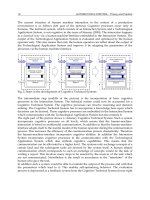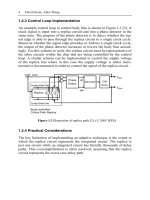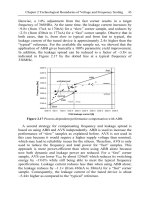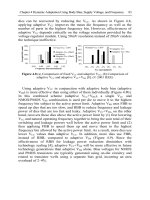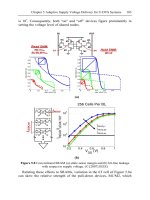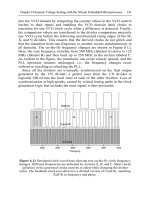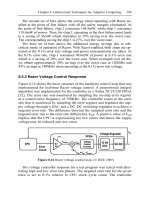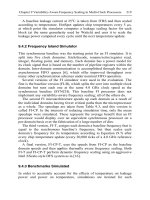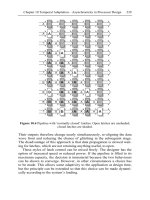Contract doctrine theory and practice vol 2 by j h verkerke
Bạn đang xem bản rút gọn của tài liệu. Xem và tải ngay bản đầy đủ của tài liệu tại đây (1.11 MB, 155 trang )
Contract Doctrine,
Theory & Practice
Volume Two
J.H. Verkerke
CALI eLangdell Press 2012
iii
Notices
This work by J.H. Verkerke is licensed and published by
CALI eLangdell Press under a Creative Commons
Attribution-Non Commercial-ShareAlike 3.0 Unported License. CALI and
CALI eLangdell Press reserve under copyright all rights not expressly
granted by this Creative Commons license. CALI and CALI eLangdell
Press do not assert copyright in US Government works or other public
domain material included herein. Permissions beyond the scope of this
license may be available through
In brief, the terms of that license are that you may copy, distribute, and
display this work, or make derivative works, so long as
you give CALI eLangdell Press and the author credit;
you do not use this work for commercial purposes; and
you distribute any works derived from this one under the same
licensing terms as this.
Suggested attribution format for original work:
J.H. Verkerke, Contract Doctrine, Theory & Practice, Published by CALI
eLangdell Press. Available under a Creative Commons BY-NC-SA 3.0
License.
Permission for the Restatement of Contracts, copyright 2012 by The
American Law Institute. Reproduced with permission. All rights reserved.
CALI® and eLangdell® are United States federally registered trademarks
owned by the Center for Computer-Assisted Legal Instruction. The cover
art design is a copyrighted work of CALI, all rights reserved. The CALI
graphical logo is a trademark and may not be used without permission.
Should you create derivative works based on the text of this book or other
Creative Commons materials therein, you may not use this book’s cover art
and the aforementioned logos, or any derivative thereof, to imply
endorsement or otherwise without written permission from CALI.
This material does not contain nor is intended to be legal advice. Users
seeking legal advice should consult with a licensed attorney in their
jurisdiction. The editors have endeavored to provide complete and accurate
information in this book. However, CALI does not warrant that the
information provided is complete and accurate. CALI disclaims all liability
iv
to any person for any loss caused by errors or omissions in this collection
of information.
v
About the Author
Before he received his law degree from Yale in 1990, J. H. (Rip) Verkerke
earned a master's of philosophy in economics. Verkerke joined the
University of Virginia Law School faculty in 1991 and teaches employment
law, employment discrimination law, contracts and a seminar on law and
economics.
While at Yale, Verkerke was articles editor and articles administrator for the
Yale Law Journal and held a number of fellowships, including the John M.
Olin Fellowship in Law, Economics, and Public Policy. After graduation, he
clerked for Judge Ralph K. Winter Jr. of the U.S. Court of Appeals for the
Second Circuit.
In June 1996 Verkerke received a three-year grant from the University of
Virginia's Academic Enhancement Program to establish the Program for
Employment and Labor Law Studies at the Law School. He served as
visiting professor of law at the University of Texas at Austin in the fall of
1997. Verkerke also participated in an ABA project to draft a new labor
code for the transitional government of Afghanistan. In 2007, Verkerke
received an All-University Teaching Award from UVA, and in 2011, he was
selected as an inaugural member of the University Academy of Teaching.
vi
About CALI eLangdell Press
The Center for Computer-Assisted Legal Instruction (CALI®) is: a
nonprofit organization with over 200 member US law schools, an
innovative force pushing legal education toward change for the better.
There are benefits to CALI membership for your school, firm, or
organization. eLangdell® is our electronic press with a mission to publish
more open books for legal education.
How do we define "open?"
Compatibility with devices like smartphones, tablets, and e-readers;
as well as print.
The right for educators to remix the materials through more lenient
copyright policies.
The ability for educators and students to adopt the materials for
free.
Find available and upcoming eLangdell titles at elangdell.cali.org. Show
support for CALI by following us on Facebook and Twitter, and by telling
your friends and colleagues where you received your free book.
vii
Summary of Contents
IV. Defining the Obligation to Perform .......................................... 1
1. Excuse ............................................................................................................. 1
2. Mistake .......................................................................................................... 15
3. Substantial Performance ............................................................................. 40
4. Exclusive Dealing Contracts ...................................................................... 49
V. Regulating the Bargaining Process .......................................... 67
1. Unconscionability ........................................................................................ 67
2. Modification ................................................................................................. 80
3. Rules Concerning Information.................................................................. 90
4. The Statute of Frauds ............................................................................... 126
viii
Table of Contents
Notices ............................................................................................................... iii
About the Author ............................................................................................. v
About CALI eLangdell Press ......................................................................... vi
Summary of Contents .................................................................................... vii
Table of Contents .......................................................................................... viii
Preface ............................................................................................................... xi
Why study contract law? .................................................................................. xi
Why collaborative teaching materials?........................................................... xi
IV. Defining the Obligation to Perform .......................................... 1
1. Excuse ............................................................................................................. 1
1.1. Principal Case – Stees v. Leonard ........................................................... 2
1.1.1. Discussion of Stees v. Leonard ..............................................................8
1.2. Principal Case – Taylor v. Caldwell ........................................................ 8
1.2.1. Paradine v. Jane..................................................................................... 13
1.2.2. Analyzing Risk ................................................................................... 14
1.2.3. Discussion of Taylor v. Caldwell ........................................................ 14
2. Mistake .......................................................................................................... 15
2.1. Principal Case – Sherwood v. Walker ................................................... 17
2.1.1 The Story of Sherwood v. Walker ........................................................ 30
2.1.2. Lenawee County Bd. of Health v. Messerly ............................................ 30
2.1.3. Discussion of Sherwood v. Walker ..................................................... 32
2.2. Principal Case – Anderson v. O’Meara ................................................ 33
2.2.1. Discussion of Anderson v. O’Meara .................................................. 40
2.2.2. Hypo of the Sterile Calf ................................................................... 40
3. Substantial Performance ............................................................................. 40
3.1. Principal Case – Jacob & Youngs v. Kent............................................. 40
3.1.1. Perfect Tender and Substantial Performance ............................... 47
3.1.2. Motion for Rehearing in Jacob & Youngs v. Kent ........................... 48
3.1.3. Discussion of Jacob & Youngs v. Kent .............................................. 48
4. Exclusive Dealing Contracts ...................................................................... 49
ix
4.1. Principal Case – Wood v. Lucy, Lady Duff-Gordon ..................... 50
4.1.1. The Background of Wood v. Lucy, Lady Duff-Gordon .................... 52
4.1.2. Reading Wood v. Lucy, Lady Duff-Gordon ......................................... 53
4.1.3. Discussion of Wood v. Lucy, Lady Duff-Gordon............................... 53
4.1.4. Hypo on Real Estate Sales ............................................................... 54
4.2. Principal Case – Bloor v. Falstaff Brewing Corp. .......................... 55
4.2.1. “Best Efforts” as Joint Maximization ............................................ 64
4.2.2. Discussion of Bloor v. Falstaff ........................................................... 65
4.2.3. Hypo on Joint Maximization........................................................... 65
V. Regulating the Bargaining Process .......................................... 67
1. Unconscionability ........................................................................................ 67
1.1. Principal Case – Williams v. Walker-Thomas Furniture Co. I ............ 68
1.2. Principal Case – Williams v. Walker-Thomas Furniture Co. II ........... 70
1.2.1. Procedural and Substantive Unconscionability ............................ 76
1.2.2. Rent-to-Own Industry and Consumer Protection Laws ............ 77
1.2.3. Uniform Commercial Code Unconscionability Provisions ....... 78
1.2.4. Discussion of Unconscionability .................................................... 79
2. Modification ................................................................................................. 80
2.1. Principal Case – Alaska Packers’ Association v. Domenico ......... 81
2.1.1. The Story of Alaska Packers Association v. Domenico ...................... 89
2.1.2. Hypo on Modification ...................................................................... 90
2.1.3. Discussion of Alaska Packers Association v. Domenico .................... 90
3. Rules Concerning Information.................................................................. 90
3.1. Fraud and Affirmative Misrepresentation ....................................... 91
3.2. Non-Disclosure and Concealment ................................................... 95
3.3. Principal Case – Reed v. King ............................................................... 95
3.4. Principal Case – Stambovsky v. Ackley .............................................. 102
3.4.1. Discussion of Reed v. King and Stambovsky v. Ackley ................... 108
3.4.2. Kronman’s Theory of Deliberately Acquired Information...... 109
3.5. Principal Case – Obde v. Schlemeyer ................................................... 113
3.5.1. Discussion of Obde v. Schlemeyer ..................................................... 119
3.6. Principal Case – L & N Grove, Inc. v. Chapman ............................. 119
3.6.1. Discussion of L&N Grove v. Chapman ......................................... 125
3.6.2. Hypo of Ivy Diamonds .................................................................. 126
3.6.3. Further Discussion of L&N Grove v. Chapman .......................... 126
x
4. The Statute of Frauds ............................................................................... 126
4.1. Principal Case – Monetti, S.P.A. v. Anchor Hocking Corp........ 127
4.1.1. Applying the UCC or Common Law Statute of Frauds ........... 139
4.1.2. Discussion of Monetti v. Anchor Hocking ....................................... 139
4.1.3. Hypo on the UCC Statute of Frauds ........................................... 139
4.1.4. Proposed Amendments to U.C.C. § 2-201 ................................. 140
xi
Preface
Our reading assignments this semester will include all of the elements that
make up a conventional casebook. You will read judicial opinions, statutory
provisions, academic essays, and hypotheticals. You will puzzle over
common law doctrines and carefully parse statutes. We will try to develop
theories that can predict and justify the patterns of judicial decisions we
observe.
Why study contract law?
The first semester of law school is mostly about learning to speak a new
legal language (but emphatically not “legalese”), to formulate and evaluate
legal arguments, to become comfortable with the distinctive style of legal
analysis. We could teach these skills using almost any legal topic. But we
begin the first-year curriculum with subjects that pervade the entire field of
law. Contract principles have a long history and they form a significant part
of the way that lawyers think about many legal problems. As you will
discover when you study insurance law, employment law, family law, and
dozens of other practice areas, your knowledge of contract doctrine and
theory will be invaluable.
Why collaborative teaching materials?
The ultimate goal of this project is to involve many professors in producing
a library of materials for teaching contracts (and other subjects). For the
moment, I will be solely responsible for collecting public domain content
and generating problems and explanatory essays. These embryonic reading
materials will grow and evolve as I use and expand them and as other
professors join in producing additional content. I gratefully acknowledge
the extraordinary work of my talented research assistants who have been
instrumental in helping me to put these materials together. Thanks to Sarah
Bryan, Mario Lorello, Elizabeth Young, Vishal Phalgoo, Valerie Barker and
Jim Sherwood.
I believe that it is equally important to involve students in the ongoing
process of refining and improving how we teach legal subjects. Our
collaboration site will provide a platform for student-generated content and
lively dialogue. With your enthusiastic engagement, we will finish the
semester with an excellent understanding of contracts and a useful
collection of reference materials. I invite each of you to join us for what will
xii
be a challenging, sometimes frustrating, but ultimately rewarding,
intellectual journey.
IV. Defining the Obligation
to Perform
We have thus far focused on the rules that determine whether the parties
have made an enforceable contract. Our attention now shifts to the
question of performance. What conduct will be sufficient to fulfill each
party’s obligation under the contract? Are there circumstances that might
excuse performance?
1. Excuse
When we make or receive promises, we understand that there are at least
some circumstances that will extinguish the resulting obligation to perform.
In social settings, a “good excuse” exists whenever an unexpected
contingency prevents someone from fulfilling her promise. If Sharon has
agreed to give several friends a ride to a concert, mechanical trouble with
her car excuses her from a duty to drive, but not from a duty to tell her
friends promptly about her inability to drive. If, however, Sharon is
seriously injured in a car accident on the way to pick up her friends, no one
would condemn her for failing to call.
What is it about our understanding of Sharon’s promise that allows us to
make these nuanced judgments about responsibility? Notice first that the
words of the promise itself play no role in establishing that mechanical
trouble would excuse performance or in distinguishing between the
consequences of mechanical trouble and personal injury. Sharon made an
unqualified promise to drive her friends to the concert, and no one expects
her to recite a litany of circumstances in which she will be unable to
perform. Instead, we rely on a shared understanding about what events
justify nonperformance.
Commercial agreements ordinarily involve comparatively complex
obligations. Their express terms likewise cover a wider array of
contingencies. However, no contract can possibly provide for every event
that might occur between the execution of the contract and the time for
performance. In the two cases that follow, consider carefully the role of
contractual language in allocating the risks of unexpected contingencies. Try
to develop a theory that can explain and perhaps justify the results in these
cases.
2
1.1. Principal Case – Stees v. Leonard
Stees v. Leonard
Supreme Court of Minnesota
20 Minn. 494 (1874)
[1] Appeal by defendants from an order of the district court, Ramsey
county, denying a new trial.
[2] The action was brought to recover damages for a failure of
defendants to erect and complete a building on a lot of plaintiffs, on
Minnesota street, between Third and Fourth streets, in the city of St.
Paul, which, by an agreement under seal between them and plaintiffs,
the defendants had agreed to build, erect, and complete, according to
plans and specifications annexed to and made part of the agreement.
The defendants commenced the construction of the building, and had
carried it to the height of three stories, when it fell to the ground. The
next year, 1869, they began again and carried it to the same height as
before, when it again fell to the ground, whereupon defendants
refused to perform the contract. They claimed that in their attempts to
erect the building they did the work in all respects according to the
plans and specifications, and that the failure to complete the building
and its fall on the two occasions was due to the fact that the soil upon
which it was to be constructed was composed of quicksand, and when
water flowed into it, was incapable of sustaining the building. The
offers of proof by defendants, and the character of the allegations in
the answer, under which the court held some of the offers
inadmissible, are sufficiently indicated in the opinion.
YOUNG, J.
[3] The general principle of law which underlies this case is well
established. If a man bind himself, by a positive, express contract, to
do an act in itself possible, he must perform his engagement, unless
prevented by the act of God, the law, or the other party to the
contract. No hardship, no unforeseen hindrance, no difficulty short of
absolute impossibility, will excuse him from doing what he has
expressly agreed to do. This doctrine may sometimes seem to bear
heavily upon contractors; but, in such cases, the hardship is
attributable, not to the law, but to the contractor himself, who has
improvidently assumed an absolute, when he might have undertaken
only a qualified, liability. The law does no more than enforce the
contract as the parties themselves have made it. Many cases illustrating
the application of the doctrine to every variety of contract are
collected in the note to Cutter v. Powell, 2 Smith, Lead. Cas. 1.
3
[4] The rule has been applied in several recent cases, closely
analogous to the present in their leading facts. In Adams v. Nichols, 19
Pick. 275, the defendant, Nichols, contracted to erect a dwelling-house
for plaintiff on plaintiff's land. The house was nearly completed, when
it was destroyed by accidental fire. It was held that the casualty did not
relieve the contractor from his obligation to perform the contract he
had deliberately entered into. The court clearly state and illustrate the
rule, as laid down in the note to Walton v. Waterhouse, 2 Wms.
Saunders, 422, and add: “In these and similar cases, which seem hard
and oppressive, the law does no more than enforce the exact contract
entered into. If there be any hardship, it arises from the indiscretion or
want of foresight of the suffering party. It is not the province of the
law to relieve persons from the improvidence of their own acts.”
[5] In School District v. Dauchy, 25 Conn. 530, the defendant contracted
to build and complete a school-house. When nearly finished, the
building was struck by lightning, and consumed by the consequent
fire, and the defendant refused to rebuild, although plaintiffs offered
to allow him such further time as should be necessary. It was held that
this non-performance was not excused by the destruction of the
building. The court thus state the rule: “If a person promise absolutely,
without exception or qualification, that a certain thing shall be done by
a given time, or that a certain event shall take place, and the thing to
be done, or the event, is neither impossible nor unlawful at the time of
the promise, he is bound by his promise, unless the performance,
before that time, becomes unlawful.”
[6] School Trustees v. Bennett, 3 Dutcher, 513, is almost identical, in its
material facts, with the present case. The contractors agreed to build
and complete a school-house, and find all materials therefor, according
to specifications annexed to the contract; the building to be located on
a lot owned by plaintiff, and designated in the contract. When the
building was nearly completed it was blown down by a sudden and
violent gale of wind. The contractors again began to erect the building,
when it fell, solely on account of the soil on which it stood having
become soft and miry, and unable to sustain the weight of the
building; although, when the foundations were laid, the soil was so
hard as to be penetrated with difficulty by a pickax, and its defects
were latent. The plaintiff had a verdict for the amount of the
installments paid under the contract as the work progressed. The
verdict was sustained by the supreme court, which held that the loss,
although arising solely from a latent defect in the soil, and not from a
faulty construction of the building, must fall on the contractor.
4
[7] In the opinion of the court, the question is fully examined, many
cases are cited, and the rule is stated “that where a party by his own
contract creates a duty or charge upon himself he is bound to make it
good if he may, notwithstanding any accident by inevitable necessity,
because he might have provided against it by his contract…. If, before
the building is completed or accepted, it is destroyed by fire or other
casualty, the loss falls upon the builder; he must rebuild. The thing
may be done, and he has contracted to do it….No matter how harsh
and apparently unjust in its operation the rule may occasionally be, it
cannot be denied that it has its foundations in good sense and
inflexible honesty. He that agrees to do an act should do it, unless
absolutely impossible. He should provide against contingencies in his
contract. Where one of two innocent persons must sustain a loss, the
law casts it upon him who has agreed to sustain it; or, rather, the law
leaves it where the agreement of the parties has put it….Neither the
destruction of the incomplete building by a tornado, nor its falling by a
latent softness of the soil, which rendered the foundation insecure,
necessarily prevented the performance of the contract to build, erect,
and complete this building for the specified price. It can still be done,
for aught that was opened to the jury as a defense, and overruled by
the court.”
[8] In Dermott v. Jones, 2 Wall. 1, the foundation of the building sank,
owing to a latent defect in the soil, and the owner was compelled to
take down and rebuild a portion of the work. The contractor having
sued for his pay, it was held that the owner might recoup the damages
sustained by his deviation from the contract. The court refer with
approval to the cases cited, and say: “The principle which controlled
them rests upon a solid foundation of reason and justice. It regards the
sanctity of contracts. It requires a party to do what he has agreed to
do. If unexpected impediments lie in the way, and a loss ensue, it
leaves the loss where the contract places it. If the parties have made no
provision for a dispensation, the rule of law gives none. It does not
allow a contract fairly made to be annulled, and it does not permit to
be interpolated what the parties themselves have not stipulated.”
[9] Nothing can be added to the clear and cogent arguments we have
quoted in vindication of the wisdom and justice of the rule which
must govern this case, unless it is in some way distinguishable from
the cases cited.
[10] It is argued that the spot on which the building is to be erected is
not designated with precision in the contract, but is left to be selected
by the owner; that, under the contract, the right to designate the
5
particular spot being reserved to plaintiffs, they must select one that
will sustain the building described in the specifications, and if the spot
they select is not, in its natural state, suitable, they must make it so;
that in this respect the present case differs from School Trustees v.
Bennett.
[11] The contract does not, perhaps, designate the site of the proposed
building with absolute certainty; but in this particular it is aided by the
pleadings. The complaint states that defendants contracted to erect the
proposed building on “ a certain piece of land, of which the plaintiffs
then were, and now are, the owners in fee, fronting on Minnesota
street, between Third and Fourth streets, in the city of St. Paul.” The
answer expressly admits that the defendants entered into a contract to
erect the building, according to the plans, etc., “on that certain piece
of land in said complaint described,” and that they “entered upon the
performance of said contract, and proceeded with the erection of said
building,” etc. This is an express admission that the contract was made
with reference to the identical piece of land on which the defendants
afterwards attempted to perform it, and leaves no foundation in fact
for the defendants' argument.
[12] It is no defense to the action that the specifications directed that
“footings” should be used as the foundation of the building, and that
the defendants, in the construction of these footings, as well as in all
other particulars, conformed to the specifications. The defendants
contracted to ““erect and complete the building.” Whatever was
necessary to be done in order to complete the building, they were
bound by the contract to do. If the building could not be completed
without other or stronger foundations than the footings specified, they
were bound to furnish such other foundations. If the building could
not be erected without draining the land, then they must drain the
land, “because they have agreed to do everything necessary to erect
and complete the building.” 3 Dutcher 520; and, see Dermott v. Jones,
supra, where the same point was made by the contractor, but ruled
against him by the court.
[13] As the draining of the land was, in fact, necessary to the erection
and completion of the building, it was a thing to be done, under the
contract, by the defendants. The prior parol agreement that plaintiffs
should drain the land, related, therefore, to a matter embraced within
the terms of the written contract, and was not, as claimed by
defendants' counsel, collateral thereto. It was, accordingly, under the
familiar rule, inadmissible in evidence to vary the terms of the written
contract, and was properly excluded.
6
[14] In their second and third offers the defendants proposed to prove
that after the making of the written contract, and when the
defendants, in the course of their excavation for the cellar and
foundation, first discovered that the soil, being porous and spongy,
would not sustain the building, unless drained, the plaintiffs proposed
and promised to keep the soil well drained during the construction of
the building; that, in consequence, the defendants did not drain the
same; that plaintiffs for a time kept the soil drained, but afterwards,
and just before the fall of the building, they neglected to drain, in
consequence of which neglect the soil became saturated with water,
and the building fell; and that a like promise was made by defendants
at the beginning of the erection of the second building, followed by
like part performance and neglect, and subsequent, and consequent,
fall of the building.
[15] The rule that a sealed contract cannot be varied by a subsequent
parol agreement, is of great antiquity, the maxim on which it rests,
unumquodque dissolvitur eodem modo, quo ligatur, being one of the most
ancient in our law. Broom, Leg. Max. 877; 5 Rep. 26 a, citing Bracton,
lib. 2, fol. 28; and, see Bracton, fol. 101. In early days the rigor with
which it was enforced in the courts of law, led to the interference of
chancery to prevent injustice. Per Lord ELLESMERE, Earl of Oxford's
Case, 2 Lead. Cas. in Eq. 508*; 1 Spence, Eq. Jur. 636. In later times
that rigor has become much relaxed, although the English courts of
law have refused to permit sealed contracts to be varied by parol in
cases of great hardship. Littler v. Holland, 3 Term R. 590; Gwynne v.
Davy, 1 Man. & Gr. 857; West v. Blakeway, 2 Man. & Gr. 729; and, see
Albert v. Grosvenor Investment Co. L. R. 3 Q. B. 123.
[16] But, in this country, it has become a well-settled exception to the
rule, that a sealed contract may be modified by a subsequent parol
agreement, if the latter has been executed, or has been so acted on that
the enforcing of the original contract would be inequitable. Munroe v.
Perkins, 9 Pick. 298; Mill-dam Foundry v. Hovey, 21 Pick. 417; Blasdell v.
Souther, 6 Gray 149; Foster v. Dawber, 6 Exch. 854, and note; Thurston v.
Ludwig, 6 Ohio St. 1; Delacroix v. Bulkley, 13 Wend. 71; Allen v. Jaquish,
21 Wend. 628; Vicary v. Moore, 2 Watts, 451; Lawall v. Rader, 24 Pa. St.
283; Carrier v. Dilworth, 59 Pa. St. 406; Richardson v. Cooper, 25 Me. 450;
Lawrence v. Dole, 11 Vt. 549; Patrick v. Adams, 29 Vt. 376; Seibert v.
Leonard, 17 Minn. 436, (Gil. 410;) Very v. Levy, 13 How. 345; 1 Smith,
Lead. Cas. (6th Ed.) 576.
[17] Whether the evidence offered shows a valid consideration for the
plaintiff's promise, or whether it shows that such promise, though
7
without consideration, has been so acted on as to inure, by way of
estoppel or otherwise, to release defendants from their obligation to
drain, are questions that were fully discussed at the bar, but which we
are not called upon to determine; for the objection is well taken by
counsel for the plaintiffs, that the evidence embraced in the second
and third offers is inadmissible under the pleadings.
[18] In their answer, the defendants allege an offer and promise by
plaintiffs (made after the defendants had commenced work under the
contract) to keep the land drained during the erection of the building.
No consideration is alleged for this promise, and, as nudum pactum, it
could of itself have no effect to vary the obligations imposed on the
defendants by the sealed contract. The answer proceeds to allege “that
the plaintiffs wholly and wrongfully failed and neglected to drain or
cause to be drained the said piece of land, or any part of the same.” It
is clear that the defendants would have no right to rely on this naked
promise, followed by no acts of plaintiffs in part performance. If the
defendants went on with the building, without taking the precaution to
drain the land, they proceeded at their own risk. The answer sets up
no facts on which an estoppel can be founded, and shows no defense
to the action.
[19] But the defendants, at the trial, offered to prove, not only that the
plaintiffs offered to drain the land, but also “that the plaintiffs did, for
a time, keep the same drained,…but afterwards they neglected to do
so,” etc. Assuming that the facts offered to be proved would
constitute a defense, (and we are not prepared to say they would not,)
no such defense is pleaded in the answer.
[20] The tendency of this proof was to establish a new defense, not
pleaded, and to contradict, rather than to sustain, the allegations of the
answer. For this reason it was inadmissible, even if the facts offered to
be proved would, if admissible constitute a defense to the action. If
the proof offered would have no such tendency, it was immaterial, and
for this reason also was rightly excluded. And as all the evidence
embraced in each offer was offered as a whole, and a part thereof was
inadmissible, the entire offers were properly rejected.
[21] The objection that the evidence offered was “incompetent,
irrelevant, and immaterial,” was sufficiently specific. The defendants'
counsel must know the contents of the answer, and that evidence
inconsistent therewith is inadmissible, if objected to.
[22] There was, therefore, no error in the exclusion of the evidence
offered, and the order appealed from is affirmed.
8
1.1.1. Discussion of Stees v. Leonard
The owners allegedly promised but failed to keep the soil drained. Why did
the Stees court refuse to entertain the argument that the owners’ promise
had modified the original contract or that the builder had relied on that
promise to its detriment?
What exactly did the contract in this case require the builder to do?
Did the parties discuss or negotiate over the possibility that the soil might
be unable to support the building?
Try applying the comparative advantage criterion to this situation. Can you
think of arguments that would support imposing the risk of poor soil
conditions on the owner? On the builder?
1.2. Principal Case – Taylor v. Caldwell
Taylor v. Caldwell
King’s Bench
3 B. & S. 826, 112 Eng. Rep. 309 (1863)
BLACKBURN J.
[1] In this case the plaintiffs and defendants had, on the 27th May,
1861, entered into a contract by which the defendants agreed to let the
plaintiffs have the use of The Surrey Gardens and Music Hall on four
days then to come, viz., the 17th June, 15th July, 5th August and 19th
August, for the purpose of giving a series of four grand concerts, and
day and night fetes at the Gardens and Hall on those days respectively;
and the plaintiffs agreed to take the Gardens and Hall on those days,
and pay 100£ for each day. The parties inaccurately call this a "letting,"
and the money to be paid a "rent;" but the whole agreement is such as
to shew that the defendants were to retain the possession of the Hall
and Gardens so that there was to be no demise of them, and that the
contract was merely to give the plaintiffs the use of them on those
days. Nothing however, in our opinion, depends on this. The
agreement then proceeds to set out various stipulations between the
parties as to what each was to supply for these concerts and
entertainments, and as to the manner in which they should be carried
on. The effect of the whole is to shew that the existence of the Music
Hall in the Surrey Gardens in a state fit for a concert was essential for
the fulfilment of the contract—such entertainments as the parties
contemplated in their agreement could not be given without it. After
the making of the agreement, and before the first day on which a
concert was to be given, the Hall was destroyed by fire. This
9
destruction, we must take it on the evidence, was without the fault of
either party, and was so complete that in consequence the concerts
could not be given as intended. And the question we have to decide is
whether, under these circumstances, the loss which the plaintiffs have
sustained is to fall upon the defendants. The parties when framing
their agreement evidently had not present to their minds the possibility
of such a disaster, and have made no express stipulation with
reference to it, so that the answer to the question must depend upon
the general rules of law applicable to such a contract.
[2] There seems no doubt that where there is a positive contract to
do a thing, not in itself unlawful, the contractor must perform it or pay
damages for not doing it, although in consequence of unforeseen
accidents, the performance of his contract has become unexpectedly
burthensome or even impossible. The law is so laid down in 1 Roll.
Abr. 450, Condition (G), and in the note (2) to Walton v. Waterhouse
(2 Wms. Saund. 421 a. 6th ed.), and is recognised as the general rule by
all the Judges in the much discussed case of Hall v. Wright (E. B. & E.
746). But this rule is only applicable when the contract is positive and
absolute, and not subject to any condition either express or implied:
and there are authorities which, as we think, establish the principle that
where, from the nature of the contract, it appears that the parties must
from the beginning have known that it could not be fulfilled unless
when the time for the fulfilment of the contract arrived some
particular specified thing continued to exist, so that, when entering
into the contract, they must have contemplated such continuing
existence as the foundation of what was to be done; there, in the
absence of any express or implied warranty that the thing shall exist,
the contract is not to be construed as a positive contract, but as
subject to an implied condition that the parties shall be excused in
case, before breach, performance becomes impossible from the
perishing of the thing without default of the contractor. There seems
little doubt that this implication tends to further the great object of
making the legal construction such as to fulfil the intention of those
who entered into the contract. For in the course of affairs men in
making such contracts in general would, if it were brought to their
minds, say that there should be such a condition. Accordingly, in the
Civil law, such an exception is implied in every obligation of the class
which they call obligatio de certo corpore. The rule is laid down in the
Digest, lib. xLv., tit. l, de verborum obligationibus, 1. 33. "Si Stichus
certo die dari promissus, ante diem moriatur: non tenetur promissor."
The principle is more fully developed in l. 23. "Si ex legati causa, aut ex
stipulatii hominem certum mihi debeas: non aliter post mortem ejus
10
tenearis mihi, quam si per te steterit, quominus vivo eo eum mihi
dares: quod ita fit, si aut interpellatus non dedisti, aut occidisti eum."
The examples are of contracts respecting a slave, which was the
common illustration of a certain subject used by the Roman lawyers,
just as we are apt to take a horse; and no doubt the propriety, one
might almost say necessity, of the implied condition is more obvious
when the contract relates to a living animal, whether man or brute,
than when it relates to some inanimate thing (such as in the present
case a theatre) the existence of which is not so obviously precarious as
that of the live animal, but the principle is adopted in the Civil law as
applicable to every obligation of which the subject is a certain thing.
The general subject is treated of by Pothier, who in his Traite des
Obligations, partie 3, chap. 6, art. 3, § 668 states the result to be that
the debtor corporis certi is freed from his obligation when the thing
has perished, neither by his act, nor his neglect, and before he is in
default, unless by some stipulation he has taken on himself the risk of
the particular misfortune which has occurred.
[3] Although the Civil law is not of itself authority in an English
Court, it affords great assistance in investigating the principles on
which the law is grounded. And it seems to us that the common law
authorities establish that in such a contract the same condition of the
continued existence of the thing is implied by English law.
[4] There is a class of contracts in which a person binds himself to do
something which requires to be performed by him in person; and such
promises, e.g. promises to marry, or promises to serve for a certain
time, are never in practice qualified by an express exception of the
death of the party; and therefore in such cases the contract is in terms
broken if the promisor dies before fulfilment. Yet it was very early
determined that, if the performance is personal, the executors are not
liable; Hyde v. The Dean of Windsor (Cro. Eliz. 552, 553). See 2 Wms.
Exors. 1560, 5th ed., where a very apt illustration is given. "Thus," says
the learned author, "if an author undertakes to compose a work, and
dies before completing it, his executors are discharged from this
contract: for the undertaking is merely personal in its nature, and, by
the intervention of the contractor's death, has become impossible to
be performed." For this he cites a dictum of Lord Lyndhurst in
Marshall v. Broadhurst (1 Tyr. 348, 349), and a case mentioned by
Patteson J. in Wentworth v. Cock (10 A. & E. 42, 45-46). In Hall v.
Wright (E. B. & E. 746, 749), Crompton J., in his judgment, puts
another case. "Where a contract depends upon personal skill, and the
act of God renders it impossible, as, for instance, in the case of a
11
painter employed to paint a picture who is struck blind, it may be that
the performance might be excused."
[5] It seems that in those cases the only ground on which the parties
or their executors, can be excused from the consequences of the
breach of the contract is, that from the nature of the contract there is
an implied condition of the continued existence of the life of the
contractor, and, perhaps in the case of the painter of his eyesight. In
the instances just given, the person, the continued existence of whose
life is necessary to the fulfilment of the contract, is himself the
contractor, but that does not seem in itself to be necessary to the
application of the principle; as is illustrated by the following example.
In the ordinary form of an apprentice deed the apprentice binds
himself in unqualified terms to "serve until the full end and term of
seven years to be fully complete and ended," during which term it is
covenanted that the apprentice his master "faithfully shall serve," and
the father of the apprentice in equally unqualified terms binds himself
for the performance by the apprentice of all and every covenant on his
part. (See the form, 2 Chitty on Pleading, 370, 7th ed. by Greening.) It
is undeniable that if the apprentice dies within the seven years, the
covenant of the father that he shall perform his covenant to serve for
seven years is not fulfilled, yet surely it cannot be that an action would
lie against the father? Yet the only reason why it would not is that he is
excused because of the apprentice's death.
[6] These are instances where the implied condition is of the life of a
human being, but there are others in which the same implication is
made as to the continued existence of a thing. For example, where a
contract of sale is made amounting to a bargain and sale, transferring
presently the property in specific chattels, which are to be delivered by
the vendor at a future day; there, if the chattels, without the fault of
the vendor, perish in the interval, the purchaser must pay the price and
the vendor is excused from performing his contract to deliver, which
has thus become impossible.
[7] That this is the rule of the English law is established by the case of
Rugg v. Minett (11 East, 210), where the article that perished before
delivery was turpentine, and it was decided that the vendor was bound
to refund the price of all those lots in which the property had not
passed; but was entitled to retain without deduction the price of those
lots in which the property had passed, though they were not delivered,
and though in the conditions of sale, which are set out in the report,
there was no express qualification of the promise to deliver on
payment. It seems in that case rather to have been taken for granted
12
than decided that the destruction of the thing sold before delivery
excused the vendor from fulfilling his contract to deliver on payment.
[8] This also is the rule in the Civil law, and it is worth noticing that
Pothier, in his celebrated Traite du Contrat de Vente (see Part. 4, §
307, etc.; and Part. 2, ch. 1, sect. 1, art. 4, § 1), treats this as merely an
example of the more general rule that every obligation de certo
corpore is extinguished when the thing ceases to exist. See Blackburn
on the Contract of Sale, p. 173.
[9] The same principle seems to be involved in the decision of
Sparrow v. Sowyate (W. Jones, 29), where, to an action of debt on an
obligation by bail, conditioned for the payment of the debt or the
render of the debtor, it was held a good plea that before any default in
rendering him the principal debtor died. It is true that was the case of
a bond with a condition, and a distinction is sometimes made in this
respect between a condition and a contract. But this observation does
not apply to Williams v. Lloyd (W. Jones, 179). In that case the count,
which was in assumpsit, alleged that the plaintiff had delivered a horse
to the defendant, who promised to redeliver it on request. Breach, that
though requested to redeliver the horse he refused. Plea, that the horse
was sick and died, and the plaintiff made the request after its death;
and on demurrer it was held a good plea, as the bailee was discharged
from his promise by the death of the horse without default or
negligence on the part of the defendant. "Let it be admitted," say the
Court, "that he promised to deliver it on request, if the horse die
before, that is become impossible by the act of God, so the party shall
be discharged, as much as if an obligation were made conditioned to
deliver the horse on request, and he died before it." And Jones, adds
the report, cited 22 Ass. 41, in which it was held that a ferryman who
had promised to carry a horse safe across the ferry was held
chargeable for the drowning of the animal only because he had
overloaded the boat, and it was agreed, that notwithstanding the
promise no action would have lain had there been no neglect or
default on his part. It may, we think, be safely asserted to be now
English law, that in all contracts of loan of chattels or bailments if the
performance of the promise of the borrower or bailee to return the
things lent or bailed, becomes impossible because it has perished, this
impossibility (if not arising from the fault of the borrower or bailee
from some risk which he has taken upon himself) excuses the
borrower or bailee from the performance of his promise to redeliver
the chattel. The great case of Coggs v. Bernard (1 Smith's L. C. 171, 5th
ed.; 2 L. Raym. 909) is now the leading case on the law of bailments,
13
and Lord Holt, in that case, referred so much to the Civil law that it
might perhaps be thought that this principle was there derived direct
from the civilians, and was not generally applicable in English law
except in the ease of bailments; but the case of Williams v. Lloyd (W.
Jones, 179), above cited, shews that the same law had been already
adopted by the English law as early as The Book of Assizes. The
principle seems to us to be that, in contracts in which the performance
depends on the continued existence of a given person or thing, a
condition is implied that the impossibility of performance arising from
the perishing of the person or thing shall excuse the performance. In
none of these cases is the promise in words other than positive, nor is
there any express stipulation that the destruction of the person or
thing shall excuse the performance; but that excuse is by law implied,
because from the nature of the contract it is apparent that the parties
contracted on the basis of the continued existence of the particular
person or chattel. In the present case, looking at the whole contract,
we find that the parties contracted on the basis of the continued
existence of the Music Hall at the time when the concerts were to be
given; that being essential to their performance.
[10] We think, therefore, that the Music Hall having ceased to exist,
without fault of either party, both parties are excused, the plaintiffs
from taking the gardens and paying the money, the defendants from
performing their promise to give the use of the Hall and Gardens and
other things. Consequently the rule must be absolute to enter the
verdict for the defendants.
[11] Rule absolute.
1.2.1. Paradine v. Jane
Suppose that a rich Englishman rents a castle from a neighboring lord.
Their brief lease agreement specifies a four-year term and a rental rate. It
also makes the lessee responsible for ordinary maintenance during the term
of the lease. Imagine now that the armies of Prince Rupert occupy the
region and force the lessee to leave the property. Would the lessee be
excused from paying rent during the occupation? Or is the lessor entitled to
receive rental payments until the end of the lease term?
Here is what one court had to say about these questions:
[I]f a house be destroyed by tempest, or by enemies,
the lessee is excused.… [W]hen the party by his own
contract creates a duty or charge upon himself, he is
bound to make it good, if he may, notwithstanding
